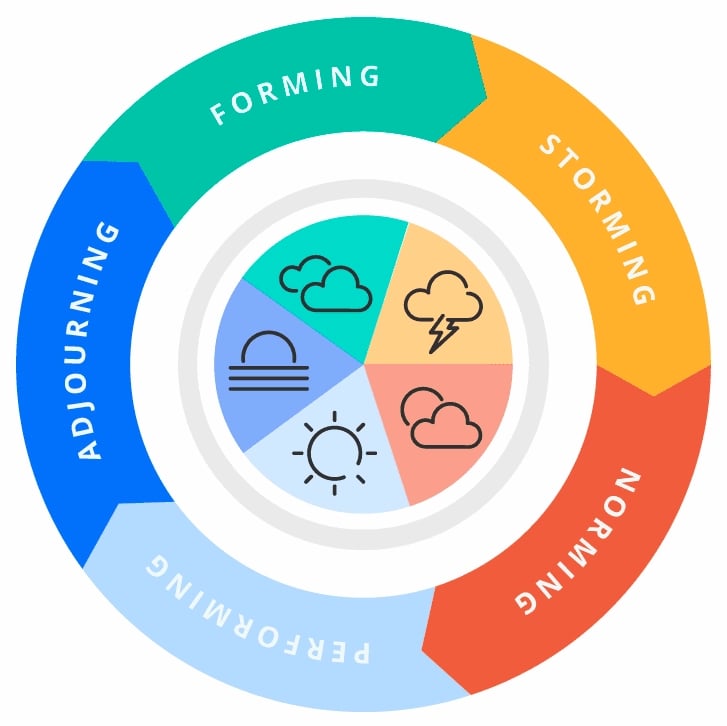Understanding team development
Team development refers to enhancing a team's performance and effectiveness through various interventions, activities, and strategies. It involves building team cohesion, fostering positive team dynamics, improving communication, enhancing problem-solving skills, and developing team members' abilities to work together towards a common goal.
Team development is an ongoing process requiring continuous effort and commitment from team leaders and team members.
Why is team development important?
Investing in team development is crucial for organisations as it brings several benefits:
- Improved performance: Team development improves team performance by enhancing communication, coordination, and collaboration among team members. When team members understand each other's strengths and weaknesses and can effectively work together, the team becomes more efficient and productive.
- Innovation and creativity: team development enables innovation and creativity by promoting an environment where team members feel safe to share their ideas and opinions. This leads to generating new ideas and solutions, driving organisational growth.
- Talent retention: team development helps in talent retention and employee engagement. When team members feel valued and supported, they are more likely to stay committed to the team and the organisation. Finally, team development enhances overall organisational performance by creating a culture of continuous improvement and learning.
Useful Read: Self-Managed Teams: A Step-by-Step Implementation Guide
The 5 stages of team development

Bruce Tuckman introduced the team development stages in 1965 and proposed the "Forming-Storming-Norming-Performing" model. Later, a fifth stage, "Adjourning," was added to the team development process by Tuckman and Jensen in 1977. Let's explore each stage in detail:
1. Forming:
In this initial stage, team members are introduced to each other and focus on getting to know one another. There is a sense of excitement and politeness in the team, but also some uncertainty and anxiety. Roles and responsibilities are not well-defined, and team members may rely heavily on the team leader for guidance.
What are your tasks as a team leader?
- Establish a clear team purpose: Clearly define the team's purpose, goals, and expectations. This helps team members understand the team's direction and creates a shared sense of purpose.
- Foster positive team dynamics: Build a positive team culture by encouraging open communication, establishing team norms, and creating a safe space for team members to share their thoughts and ideas.
- Provide guidance and direction: Offer clear guidance and direction to team members, as they may still be getting acquainted with each other and the team's goals. Clarify roles, responsibilities, and expectations to set a strong foundation for the team.
2. Storming:
As team members start working together, differing opinions, working styles, and expectations may surface, leading to conflicts and disagreements. This is a critical stage where team members may challenge each other's ideas and authority. Firstly, team members resolve conflicts and then it is the responsibility of the team leader to manage conflicts and facilitate effective communication to resolve issues.
What are your tasks as a team leader?
- Manage conflicts: Address conflicts and disagreements among team members promptly and effectively. Act as a mediator and facilitate open and constructive discussions to resolve conflicts and prevent them from escalating.
- Foster collaboration: Encourage teamwork and collaboration among team members. Emphasize the importance of working together towards common goals and finding solutions collectively.
- Provide support: Offer support to team members who may be struggling with the challenges of the storming stage. Provide coaching, mentoring, and resources to help them navigate through the difficulties.
3. Norming:
In this stage, team members begin to find common ground, develop trust, and establish norms and values that guide their behavior. There is a growing sense of cohesion and cooperation among team members. Roles and responsibilities become clearer, and the team starts to work more collaboratively towards achieving their goals.
What are your tasks as a team leader?
- Reinforce team norms: Encourage and reinforce positive team norms and behaviors that have emerged during the norming stage. Recognize and celebrate team achievements and milestones.
- Promote inclusivity: Foster inclusivity and diversity within the team. Encourage team members to respect and value each other's perspectives and opinions and ensure that everyone's voice is heard.
- Facilitate communication: Continue to promote open communication and feedback among team members. Encourage regular team meetings and discussions to ensure that everyone is aligned and working towards the team's goals.
4. Performing:
At the performing stage, the team reaches its peak performance level. Team members work together seamlessly, leveraging each other's strengths and achieving their objectives effectively and efficiently. There is a high level of trust, open communication, and a shared sense of purpose among team members. The team is self-managing and requires minimal intervention from the team leader.
What are your tasks as a team leader?
- Empower entire team members: Delegate tasks and responsibilities to team members based on their strengths and expertise. Encourage autonomy and decision-making at the team level.
- Facilitate continuous improvement: Encourage team members to seek feedback, reflect on their performance, and identify areas for improvement. Facilitate discussions on how the team can continuously enhance its performance.
- Recognize and reward achievements: Acknowledge and celebrate the team's achievements and successes. Give team members regular feedback and recognition to reinforce positive behaviors and performance.
5. Adjourning:
This stage is also known as "mourning" or "transforming." It is not always applicable to all teams, but it is relevant to teams with a specific project-based or temporary nature. In this stage, the team celebrates its achievements and reflects on the lessons learned. Team members may also experience a sense of loss or separation as the team dissolves or transitions to other projects. The team leader plays a vital role in recognizing and acknowledging the team's efforts and providing closure to team members.
What are your tasks as a team leader?
- Provide closure: Facilitate closure as the team completes its tasks or projects. Reflect on the team's accomplishments and lessons learned during the team's journey.
- Support transition: Support team members in transitioning to new roles or projects. Offer guidance and resources to help them adapt to the changes.
- Celebrate team's success: Celebrate the team success and acknowledge the contributions of each team member. Express gratitude and appreciation for their efforts and commitment throughout the team's development journey.
Strategies for Success

Building and nurturing high-performing teams require deliberate strategies and actions. Here are some strategies for success in team development:
- Establish clear goals and expectations: Clearly define the team's purpose, goals, and expectations from the outset. Ensure that all team members understand and are aligned with these objectives. This helps set a shared sense of purpose and direction for the team, fostering motivation and commitment.
- Foster open communication: Encourage open and honest communication among team members. Create an environment where team members feel comfortable expressing their thoughts, opinions, and concerns. Effective communication promotes understanding, trust, and collaboration, which are essential for team development.
- Build trust and relationships: Trust is the foundation of any successful team. Encourage team members to build relationships, develop mutual respect, and establish trust among themselves. Foster a positive team culture where team members feel valued, supported, and included.
- Develop leadership skills: Invest in developing leadership skills among team members, including the team leader. Effective leadership is crucial in guiding and motivating the team toward achieving its goals. Encourage leadership at all levels of the team, and provide opportunities for team members to develop leadership skills.
- Foster collaboration and diversity: Encourage collaboration and teamwork among team members. Leverage team members' diverse perspectives, strengths, and skills to foster innovation and creativity. Avoid silos and promote cross-functional collaboration to achieve team goals.
- Provide regular feedback and recognition: Provide regular feedback to team members on their performance, both individually and collectively. Recognize and celebrate the team's achievements and milestones. Feedback and recognition promote continuous improvement and motivation among team members.
- Provide opportunities for learning and development: Invest in team members' learning and development by providing opportunities for skill-building, training, and professional growth. This not only enhances team members' capabilities but also strengthens the team as a whole.
- Manage conflict effectively: Conflict is inevitable in any team. However, managing conflict effectively is crucial for team development. Encourage open and constructive discussions to resolve conflicts and prevent them from escalating. Provide support and mediation as needed.

Employee scheduling and Time-tracking software!
Tools for effective team development and management
Effective team development and management require the use of various tools and techniques to enhance team performance, collaboration, and communication. Here are some tools that can be utilized for effective team development and management:
Project management software:
Project management software, such as Trello, Asana, or Microsoft Project, can be used to assign tasks, set deadlines, track progress, and collaborate on projects. These tools provide a visual overview of the team's workload, responsibilities, and progress, helping streamline workflows and ensure everyone is on the same page.
Communication and collaboration tools:
Tools like Slack, Microsoft Teams, or Google Workspace provide team communication, collaboration, and file-sharing platforms. They facilitate real-time communication, document sharing, and team collaboration, even when team members are in different locations. These tools enable efficient communication, coordination, and collaboration among team members, regardless of their physical location.
Performance management tools:
Performance management tools, such as 360-degree feedback tools, can provide feedback from multiple perspectives to help team members improve their performance. These tools allow team members to assess their own performance and receive feedback from peers, managers, and stakeholders. They can be used to set goals, track progress, and provide feedback, helping team members grow and develop their skills.
Useful Read: The 6 top Employee Performance Management Trends
Team-building activities and assessments:
Team-building activities, such as workshops, retreats, or assessments, can enhance team dynamics, communication, and collaboration. These activities can help team members understand each other's strengths, weaknesses, and working styles and foster mutual respect and trust. Team-building activities can improve team cohesion, boost morale, and enhance team performance.
Training and development programs:
Training and development programs, such as workshops, seminars, or online courses, can be used to develop team members' skills, knowledge, and capabilities. These programs can cover various topics, such as leadership, communication, conflict resolution, and problem-solving, to enhance team members' capabilities and effectiveness.
Feedback and performance evaluation tools:
Feedback and performance evaluation tools, such as performance appraisal software or platforms, can provide regular feedback, evaluate team members' performance, and set performance goals. These tools can facilitate ongoing feedback and performance discussions and help team members align their performance with team goals and expectations.
Team assessment tools:
Team assessment tools, such as personality assessments or team assessments, can provide insights into team dynamics, strengths, and areas for improvement. These assessments can help team members understand their own and each other's strengths, communication styles, and working preferences. This understanding can lead to improved team communication, collaboration, and performance.
Performance dashboards and analytics tools:
Performance dashboards and analytics tools, such as data analytics software or visual dashboards, can provide insights into team performance, progress toward goals, and areas for improvement. These tools can help team leaders track key performance metrics, make data-driven decisions, and continuously improve team performance.
Conclusion
Team development is a crucial aspect of organisational success. By understanding the stages of team development and implementing effective strategies, organisations can build and nurture high-performing teams that are capable of achieving their goals and driving organisational success.
Investing in team development improves team performance, enhanced innovation, higher employee engagement, and overall organisational excellence. By prioritizing team development, organizations can create a culture of collaboration, continuous learning, and high performance, ultimately leading to sustainable success.






